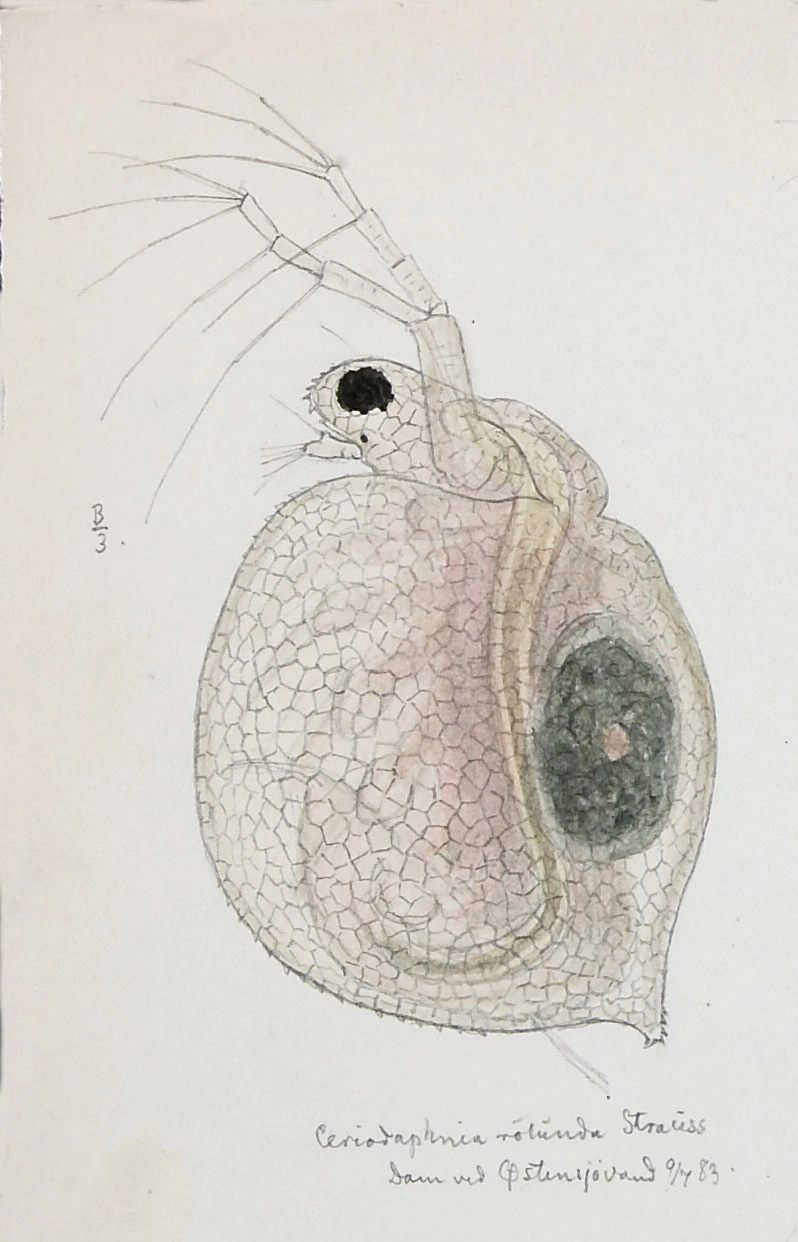Ceriodaphnia rotunda
Ceriodaphnia rotunda has a more or less circular shape and the ventral part of its small head is somewhat pointed and ends in a rounded tip carrying 4–6 small teeth. It is only found in Southeast Norway.
Key characteristics
Ceriodaphnia rotunda (female)
Ceriodaphnia rotunda has a more or less circular shape and its head is comparatively small. The ventral part of the head is somewhat pointed and ends in a rounded tip carrying 4–6 small teeth. The first pair of antennae is broad near the base and narrows towards the anterior end where a group of exceptionally long bristles are attached. The post abdomen is especially wide in the middle forming an angle towards the posterior end which has about seven small teeth. Except for the first and the last tooth, which is quite small, the rest are about the same size. It is strongly reticulated, and its colour can be dark reddish brown or greyish red.
Female: Length 0.7–1.0 mm
Male: Length 0.6 mm
Ecology and distribution
Females of C. rotunda were found in a pond in Oslo by G.O. Sars in ca 1860. Later the species has been recorded from four localities in the vicinity of Oslo and from three sites in the delta of the rivers Etna and Dokka north of Oslo. All sites can be characterized as electrolyte rich (>10 mS/m), alcaline (pH>6.5) lowland localities. According to Flössner (1971), C. rotunda is common in small ponds with dense vegetation where it can co-occur with C. laticaudata.
| Vitenskapelig navn | < 4,5 | 4,5 - 4,9 | 5,0 - 5,4 | 5,5 - 5,9 | 6,0 - 6,4 | 6,5 - 7,0 | 7,0 - 7,4 | > 7,5 |
|---|---|---|---|---|---|---|---|---|
| 0 | 0 | 0 | 0 | 0 | 0,8 | 0,4 | 2,4 |
| Vitenskapelig navn | < 1,0 | 1,0 - 1,4 | 1,5 - 1,9 | 2,0 - 2,9 | 3,0 - 3,9 | 4,0 - 4,9 | 5,0 - 6,9 | 7,0 - 9,9 | > 10,0 |
|---|---|---|---|---|---|---|---|---|---|
| 0 | 0 | 0 | 0 | 0 | 0 | 0 | 0 | 2,6 |
| Vitenskapelig navn | < 0,01 | 0,01 - 0,09 | 0,1 - 0,9 | 1,0 - 9,9 | 10,0 - 99 | 100 - 999 | > 1000 |
|---|---|---|---|---|---|---|---|
| 0 | 2 | 0 | 0,6 | 0,1 | 0 | 0 |
| Vitenskapelig navn | < 100 | 100-299 | 300-499 | 500-699 | 700-999 | >1000 |
|---|---|---|---|---|---|---|
| 0,4 | 0,9 | 0 | 0 | 0 | 0 |
Look-alikes
Ceriodaphnia pulchella, C. quadrangula and C. laticaudata



